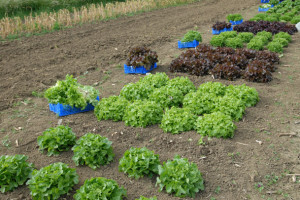“If you can’t pencil a profit, you aren’t likely to make one.”
by Karen McSwain, Farm Services Director
CFSA’s new 2015 Organic Enterprise Budgets are now on our website and free for you to use. The 2013 budgets have been updated based on the input of a farmer focus group. The budgets are based on one acre of production on a ten-acre farm, selling to wholesale markets. As far as we know, these are the only organic enterprise budgets for these crops developed for farmers in the Southeast.
Crop enterprise budgets are a useful tool to help you determine whether the resource and labor inputs you invest in a particular crop are generating a profit. They provide a realistic projection of the estimated yield, income, expenses, and profit for a single crop per year. They include variable costs – costs that are incurred because a farmer chooses to grow a specific crop – and fixed costs – costs that a farmer incurs whether or not a crop is grown on that piece of land.
Variable costs include things like purchasing seeds or transplants, compost or manure, mulch, fuel, the cost of running irrigation, etc. Fixed costs include machinery and equipment costs, the cost of land, and the cost of irrigation equipment. Enterprise budgets are different from a whole farm budget, which estimates total farm production, income, expenses and profit and includes things like vehicles, cold storage, packing sheds, and barns.
Our crop enterprise budget tools come in two different formats: baseline budgets that provide an average of production costs and interactive budgets, which allow you to develop budgets specific to your operation. Good records from your own farm will result in more accurate budget projections. CFSA has compiled a list of free downloadable templates to help you capture good records. CFSA has also reviewed a number of commercially available record keeping software programs to help you determine which one will work for you.
Both beginning and seasoned farmers will find the enterprise budgets helpful.
If you are a new grower just starting out and have not had a growing season or two to record, you can use the baseline enterprise budgets to get a good idea about how much time and money you will need, what the inputs are, and which crops might be most profitable. While you might not be growing one acre of tomatoes on a ten acre farm, a little bit of division is all you need to adjust the costs to your operation.
If you are a certified organic farmer, you can develop enterprise budgets specific to your operation to consider increasing production of profitable crops or decreasing production of less profitable crops. Comparing your budgets with our baseline budgets will also help to see if your production costs are in line with ours.
If you find your costs are much higher than those in the baseline budget, this might be a good place to develop systems to reduce those costs. You may want to track labor closely for a season to get a sense of what activities are taking the most time and if there are ways you can reduce the time spent doing those activities. For example, if you have been thinking about buying a transplanter, how much labor costs will the investment in a transplanter save in the long run?
If you are a seasoned farmer considering transitioning to certified organic, you can compare the costs and returns for organic production with your current operation. The table below compares the return above total costs from our baseline organic budgets with traditional budgets developed by Clemson University.
Developing your own crop enterprise budgets and comparing yours with the CFSA Organic Crop Budgets or the Clemson Traditional Crop Budgets will provide the information you need to know what crops to grow and how to price them in order to stay in business.
|
CROP |
Organic Return Above Total Costs* |
Non-Organic Return Above Total Costs** |
| Broccoli |
$4,110.00 |
NA |
| Cabbage |
$9,720.00 |
$2,040.53 (spring) |
| Cucumbers |
$14,234.00 |
$1,519.06 |
| Greens (Turnip, Mustard, Collards) |
$4,863.00 |
$3,063.66 |
| Irish Potatoes |
$6,832.00 |
NA |
| Leaf Lettuce |
$2,626.00 |
NA |
| Summer Squash |
$113.00 |
$1,369.68 |
| Sweet Potatoes |
$7,738.00 |
$5,732.37 |
| Tomatoes |
$21,901.00 |
$14,652.07 |
| Watermelon |
$3,054.00 |
$2,206.34 |
Comparison of return above total costs (variable costs + fixed costs – return) for organic versus non-organic fruit and vegetable crops. *Organic costs based on CFSA’s Organic Enterprise Budgets. **Non-organic costs based on Clemson Cooperative Extension’s Traditional Vegetable Budgets.



